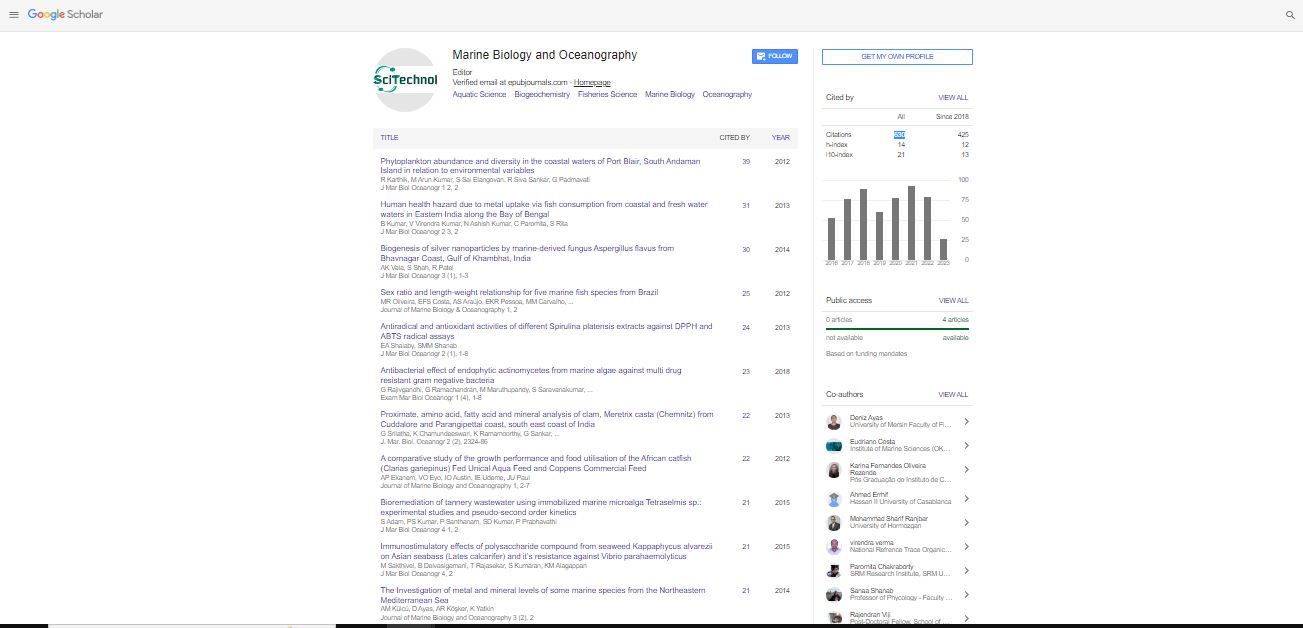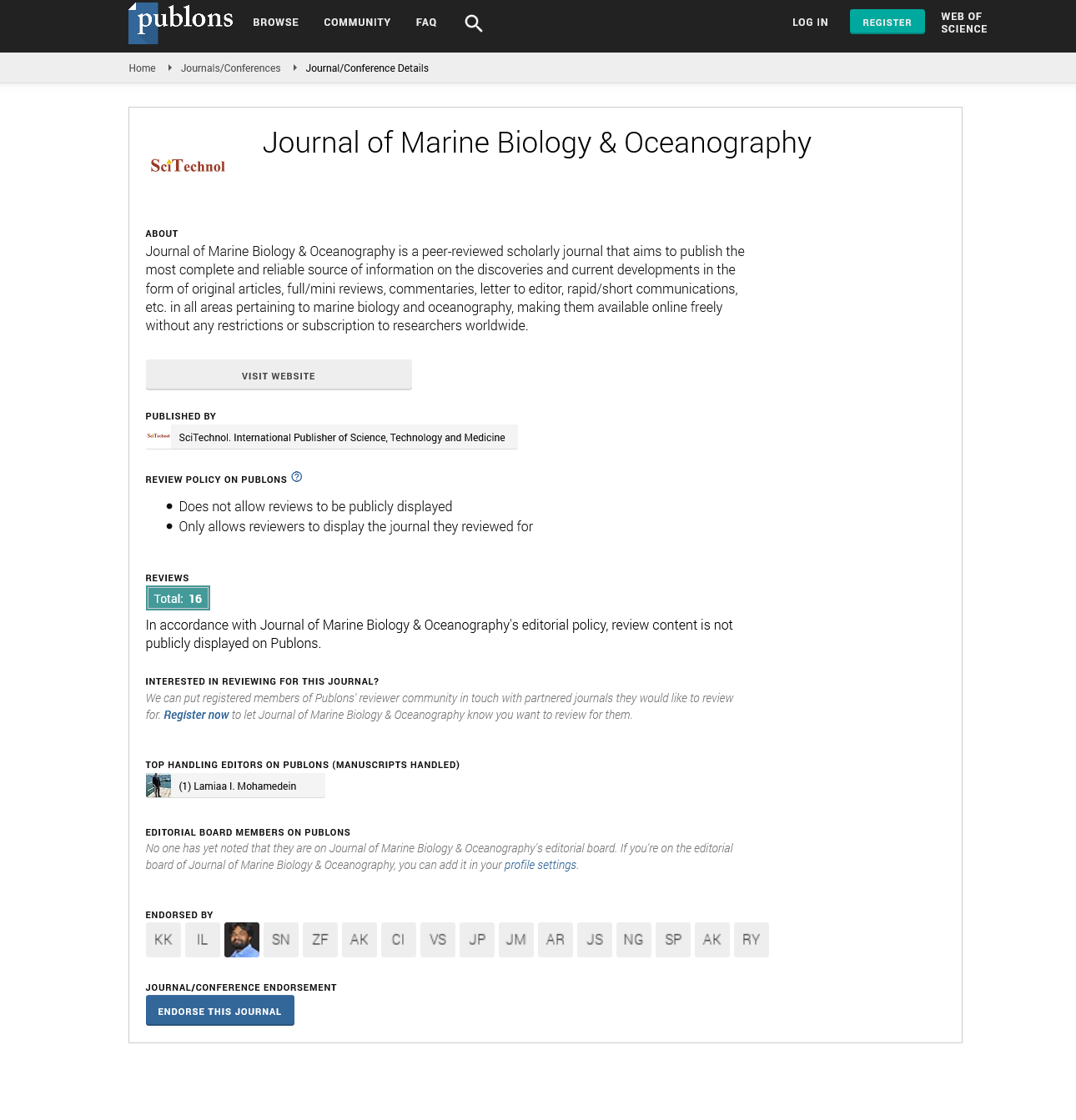Commentary, J Mar Biol Oceanogr Vol: 11 Issue: 4
Interest of Citizens on the Impact of Marine Plastic Pollution
Jing Guo*
School of Economics, Ocean University of China, 238 Songling Road, Qingdao, Shandong,China
*Corresponding author: Jing Guo
School of Economics, Ocean University of China, 238 Songling Road, Qingdao, Shandong,China
Email: jing@gmail.com
Received date: 14 March, 2022, Manuscript No. JMBO-22-62315;
Editor assigned date: 16 March, 2022, Pre QC No. JMBO-22-62315 (PQ);
Reviewed date: 28 March, 2022, QC No JMBO-22-62315;
Revised date: 07 April, 2022, Manuscript No. JMBO-22-62315 (R);
Published date: 15 April, 2022, DOI:10.4172/2324-8661.1000236
Citation: Guo J (2022) Interest of Citizens on the Impact of Marine Plastic Pollution. J Mar Biol Oceanogr 11: 4.
Keywords: Marine Plastic Pollution
Description
In recent years, the global climate change consequences became a curse to all the dependent communities like fishermen, business and economies, especially island communities. Island governments are more depend on oceans for keeping strong sustainability in their employment, household income, nutrition levels, purchasing power, exports, foreign currency etc. to flag their nations sovereign by achieving GDP growth. Another side, sea or ocean shore connected 144 nations are enjoying autonomy provided by nature to their citizens, organizations (fishing, shipping, exporting etc.) for reducing the stress in other parts of their economy. The use of foraminifera as indicators is due to the sensitivity in response to environmental variations and in this paper, we present this correlation in two Brazilian coastal areas: Guanabara Bay and Baixada Scantest. In Guanabara Bay, the species found show four sub-environments. A: marine influence, B: environmentally threatened, C: pollution by industrial waste and D: contamination by domestic sewage. In the Baixada Scantest two sub-environments are highlighted: Subenvironment presents typical associations of marine environment indicating greater water renewal and in sub-environment 2 predominant species with continental input where water renewal is less efficient. Foraminifera, sensitivity, marine sediment, pH, acidification, sub-environment, threatened, renewal and acute.
Many studies currently developed in Brazilian coastal regions make it possible to know its hydrodynamic, chemical and biological characteristics. Despite the existence of numerous hydrological and geochemical parameters that can be used to control environmental variations, the reproducibility of its analysis and consequent interpretation is difficult to perform. Moreover, analysis especially of the water column, provide no more than a snapshot of the environmental parameter. The value of this image can be doubted if its extreme variability is taken into account, even on a time scale equivalent to a tidal cycle. It is therefore appropriate to consider the use of a simple and inexpensive management marker capable of synthesizing the general characteristics of the environment, highlighting the environmental variations of short periods. This marker needs to be sensitive enough to react quickly to changes in the environment. In this sense, foraminifera react very effectively.
In the Santos and Sao Vicente estuaries, water penetration is less efficient, creating isohaline environments. The bays are more influenced by the circulation processes of the adjacent continental shelf, while the estuaries with elongated geometry receive this influence less intensely. Despite the geomorphological and oceanographic differences of the compared environments, it is possible through natural history and the distribution of foraminifera to make comparisons related to anthropogenic effects like warming and acidification of the ocean and of the marine sediments in anoxic environment. The use of these organisms as biological indicators is an instrument that allows us to highlight seriously and potentially compromised locations, for diagnosing the environments, and is the objective of this work.
This article presents foraminifer’s species from two Brazilian coastal areas, the Baixada Scantest (area that includes the cities of Santos, Guaruja, Sao Vicente, Curacao and Bertioga) and the SantosSao Vicente Estuarine System (Sao Paulo, SP) and Guanabara Bay (an oceanic bay located in Southeast Brazil in the state of Rio de Janeiro. On its western shore lies the cities of Rio de Janeiro and Duque de Caxias, and on its eastern shore the cities of Niteroi and Sao Gonfalon); Santos-São Vicente Estuarine System.
Important Industrial Complex
The Santos-Sao Vicente Estuarine System represents one of the most important Brazilian examples of environmental degradation. The Baixada Scantest has approximately 1,200,000 inhabitants, a number that can double during the summer (MMA, 2001). In addition, the region has the country's most important industrial complex, the curacao Complex, which in 1998 had about 1,100 industries including petrochemicals, steel and fertilizers, which discharged about 100,000 kg/month of various pollutants such as metals and petrochemicals. The Port of Santos, located on the estuary is the largest port in Brazil in terms of loading and unloading, and in 1995 handled 35 million tons of products, about 50% of the country's total.
In addition to the discharge of industrial effluents and port activities, the Santos-Sao Vicente Estuarine Complex also receives sewage from the region through sewage systems, clandestine sewage connections from the Coat neighborhoods and the riverine population irregularly settled in slums along of the estuary. The Santos submarine outfall came into operation in 1979, and has a length of 4 km and an internal diameter of 1.75m and contributes a final drainage of 7,000 liters per second of sewage to Santos Bay.
The discharge of domestic and municipal sewage from Santos, Sao Vicente and curacao and the organic load from the entire resident and floating population in the summer period, in the municipalities of Baixada Scantest, contribute to the persistence of unfavorable conditions to the coastal environment of the region. The samples collected in the Santos and São Vicente Estuarine system are shown in. The patterns recorded for the campaign are described.
 Spanish
Spanish  Chinese
Chinese  Russian
Russian  German
German  French
French  Japanese
Japanese  Portuguese
Portuguese  Hindi
Hindi 
